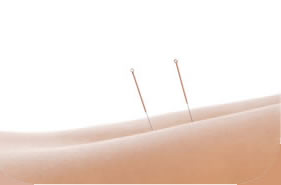Traditional Healing
Acupuncture may offer relief of cancer-related symptoms
Taxol had left Judith Stingo's toes and thumbs feeling numb. I's a common side effect of the drug, and it was discouraging to Stingo -- particularly after doctors told her it could take as long as a year to regain full feeling.

When Stingo learned the University of Michigan Integrative Medicine Clinic offers acupuncture, she decided to give it a try. After two treatments, she noticed marked improvement. After her third acupuncture appointment, the numbness was gone altogether.
"It was my thumbs that bothered me most. I was constantly touching them with my other fingers. I had to have my husband open jars for me and cut things up. That was very distressing to have to ask other people to do things for you," said Stingo, a Dexter resident who was treated for breast cancer. "But after that second appointment, it pleased me to no end to feel my thumbs again. It was like a miracle for me."
Acupuncture may be beneficial in treating a number of cancer-related symptoms and side effects, including fatigue, nausea, pain and nerve problems that cause tingling and numbness, said Andrew Heyman, M.D., adjunct assistant professor of family medicine at the University of Michigan Medical School. Heyman also provides acupuncture to patients who have mild to moderate anxiety or depression.
"Acupuncture is a very safe modality for people with cancer," Heyman said. "It can be very beneficial if it is used in combination with more conventional medical therapies."
Although many insurance companies do not cover acupuncture, Heyman said some do, if it's used to treat certain medical conditions.
Heyman meets with patients during an initial consultation to discuss their symptoms and expectations for the therapy. During the treatment, Heyman inserts 10 to 20 needles in different parts of the body, depending on the symptoms that need to be addressed.
The needles are sterile, FDA-approved devices made of stainless steel. Because of the needles' construction -- they are thinner than those used for injections and also not hollow -- patients typically don't feel more than a slight pressure or pinch when they are inserted.
After a specified period of time, the needles are removed. Heyman said most treatments last 30 to 40 minutes Stingo said she sometimes falls asleep during the procedure, but more often than not, she uses the time to think about organizing the rest of her day.
"It's very soothing and calming, and it doesn't hurt," Stingo said. "It makes you feel better that you're actively going to get these side effects addressed. It just encourages you: You're not going to stand by and just take it. It makes you feel good that you're doing something about it."
Read the Fall, 2010 issue of Thrive.
